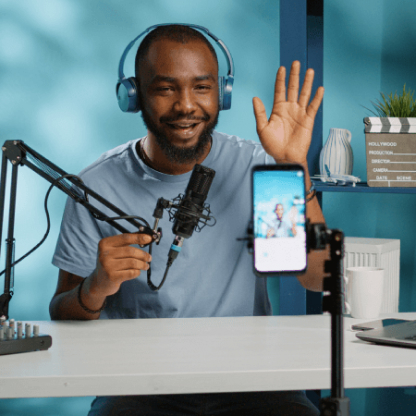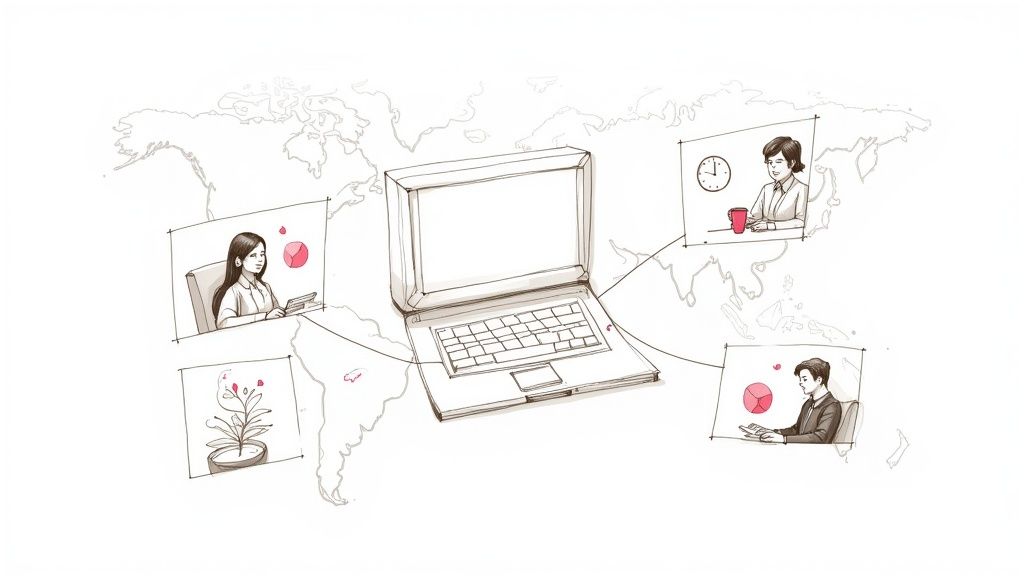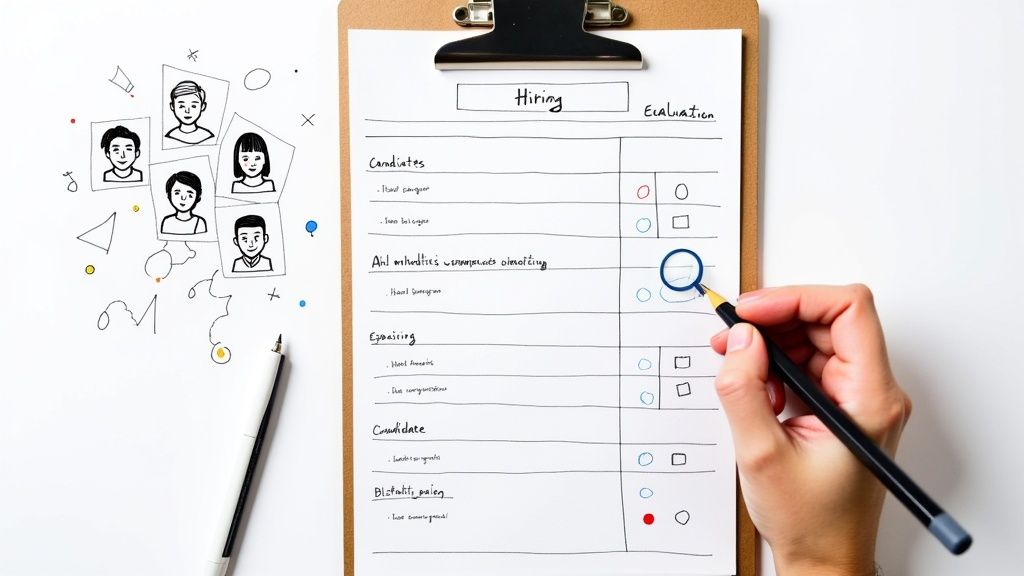Let's be honest, traditional first-round interviews are a colossal waste of time. They're like a series of expensive, bad first dates where nobody has any fun. On demand video interviewing is the modern fix, allowing you to screen more candidates, faster, without mortgaging your office ping-pong table.
Your Hiring Process Is An Awkward First Date
You know the drill. You spend hours coordinating schedules, repeating the same introductory questions, and trying to gauge a personality from a 30-minute phone screen that feels more like an interrogation. Hope you enjoy spending your afternoons playing calendar Tetris—because that’s now your full-time job.
This back-and-forth isn't just inefficient; it's a terrible first impression. Top candidates are interviewing you just as much as you're interviewing them. A clunky, slow process screams that your company might be just as disorganized internally. That's not a great look.
The Promise of a Better Way
This is where on-demand video interviewing enters the chat. It promises a better way—a method to screen candidates on your time, get deeper insights than a resume provides, and reclaim hours of your week. But here’s the catch: not all platforms are created equal.
Many turn this promising idea into a robotic, impersonal experience that scares away great talent faster than you can say, "please record your answer after the beep."
The goal isn't just to automate your screening process; it's to make it better. More efficient, yes, but also more human, more insightful, and less of a chore for everyone involved.
This guide is for founders and hiring managers tired of the old way but skeptical of the new. We'll cut through the marketing fluff to show you what really works. We’ll cover how to build a process that's both ruthlessly efficient and surprisingly human, a crucial first step in any plan for recruiting process improvement.
A New Foundation for Hiring
Think of this as your new playbook. Instead of a stack of resumes that recruiters spend an average of 30 seconds skimming, you get thoughtful, prepared answers. You’re not just matching keywords; you're seeing communication skills, personality, and genuine interest firsthand.
This isn't about replacing human connection. It's about saving it for the candidates who actually matter. By streamlining the initial steps, you free up your team to focus on meaningful, late-stage conversations with the real contenders.
Building a solid foundation for this approach is key, which is why having a structured plan, like the one outlined in this detailed hiring process checklist, can make all the difference. We’re here to show you how to do it right.
What Exactly Is On Demand Video Interviewing?
Forget the endless email chains and the game of calendar Tetris. On demand video interviewing is like a DVR for your initial screening calls. You’re no longer a prisoner to your schedule, trying to find a 30-minute slot that works for you, three team members, and a dozen candidates spread across different time zones.
Instead, you just send a link with your key questions. Candidates can record their answers whenever it works for them—after their kids are asleep, on a Saturday morning, you name it. Then, you and your team watch the responses when you have a free moment. It’s really that simple.
This asynchronous approach isn't just about convenience; it’s about taking back your calendar from the logistical black hole of interview scheduling.
The Asynchronous Advantage
Think of it this way: a traditional phone screen is a live performance. If the connection drops or the candidate is just having an off day, that’s it—the opportunity is gone. But an on-demand interview is more like a recorded audition. It gives candidates a real chance to put their best foot forward, and it gives you the ability to review them fairly and consistently.
The workflow is brutally simple:
- You Create: You design an interview with a few crucial questions. You can even add a welcome video from the hiring manager to make it feel less robotic.
- They Record: Candidates get an invite and record their responses using their phone or laptop. No scheduling, no back-and-forth.
- You Review: Your team can watch, rate, and leave comments on the submissions whenever they have a spare moment between meetings.
This isn’t some far-off, futuristic idea. Companies that make the switch see immediate, tangible results. We're talking a 50% reduction in time-to-hire and a staggering 70% decrease in the time spent scheduling. Those aren't vanity metrics; that's real time back in your day.
The Numbers Don't Lie
Let's break down exactly how much time and effort this saves. When you compare the old way of doing things with on-demand interviews, the difference in efficiency is dramatic.
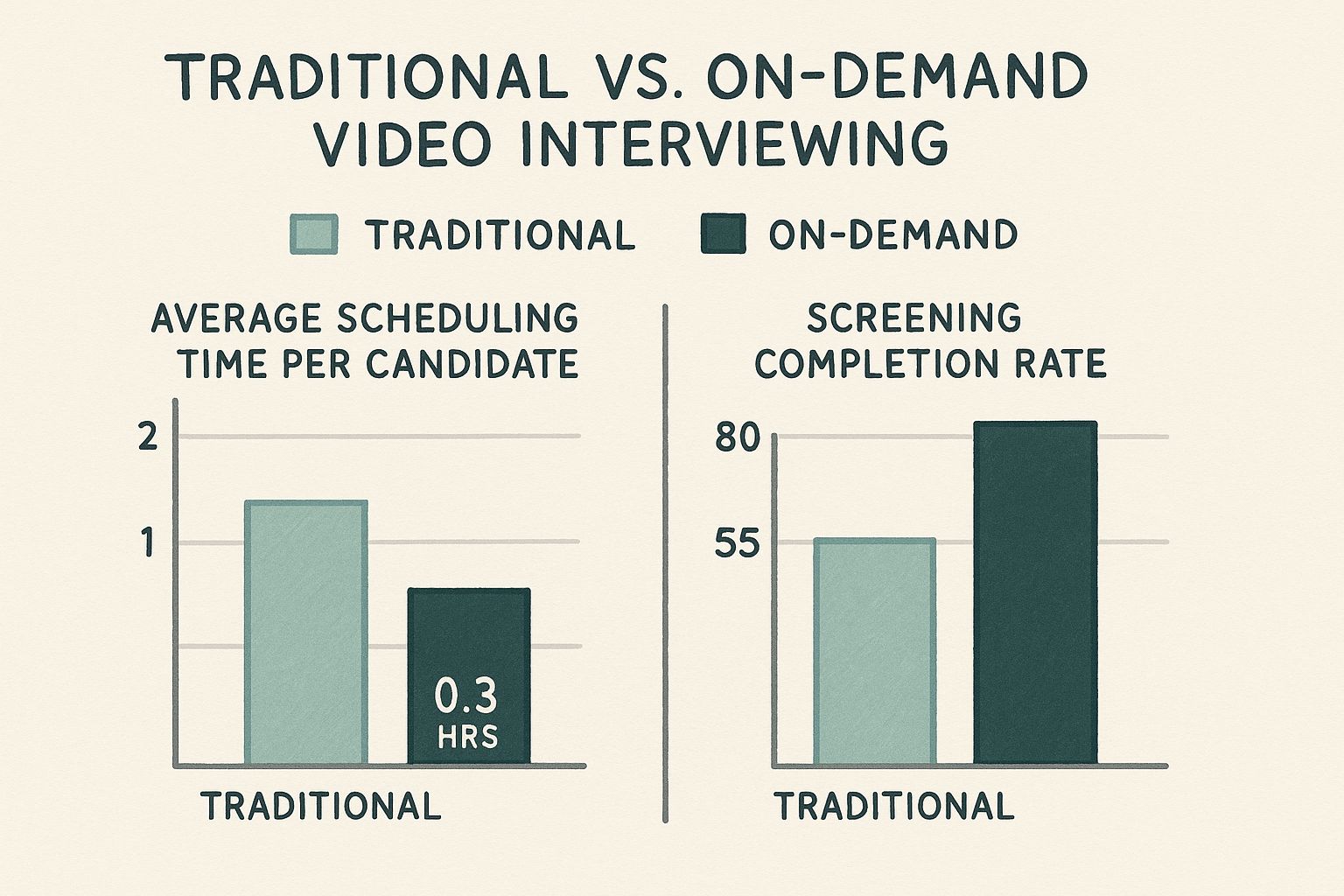
As you can see, you're not just shaving off a few minutes here and there. You’re fundamentally changing the resource drain of initial screening while actually getting more candidates through the door.
To put it in perspective, let's look at a side-by-side comparison of the effort involved.
| Metric | Traditional Phone Screen | On-Demand Video Interview |
|---|---|---|
| Scheduling Effort | A mess of back-and-forth emails, reschedules, and calendar invites. | Zero. Just send one link to all candidates. |
| Time per Candidate | Typically 30 minutes of live, scheduled time per candidate. | 5-10 minutes to review responses at your convenience. |
| Candidate Flexibility | Low. Candidates must be available during your specific business hours. | High. Candidates can record anytime, anywhere. |
| Team Collaboration | Difficult. Requires multiple people to sync schedules or rely on second-hand notes. | Easy. Share videos, leave time-stamped comments, and rate candidates on one platform. |
It's clear that on-demand video interviews offer a much more efficient, scalable, and candidate-friendly way to handle the top of your hiring funnel.
Beyond a Simple Recording
But this process does a lot more than just save time. It standardizes your initial screening, making sure every single candidate gets the exact same questions delivered in the exact same way. This helps create a more level playing field and can mitigate the unconscious bias that often creeps into unstructured phone calls.
It's about moving from subjective first impressions to structured, data-driven decisions. You’re comparing apples to apples, based on thoughtful answers to consistent questions—not just how someone happened to sound on the phone at 8 AM.
By front-loading your process with this kind of structured evaluation, you can identify your top contenders with much more confidence. That means you get to spend your valuable live interview time talking to the people who are truly a great fit. For a deeper look at the mechanics, check out our guide on what a digital interview entails. It’s a small shift in process that leads to a massive improvement in your hiring outcomes.
The Good, The Bad, And The Painfully Awkward
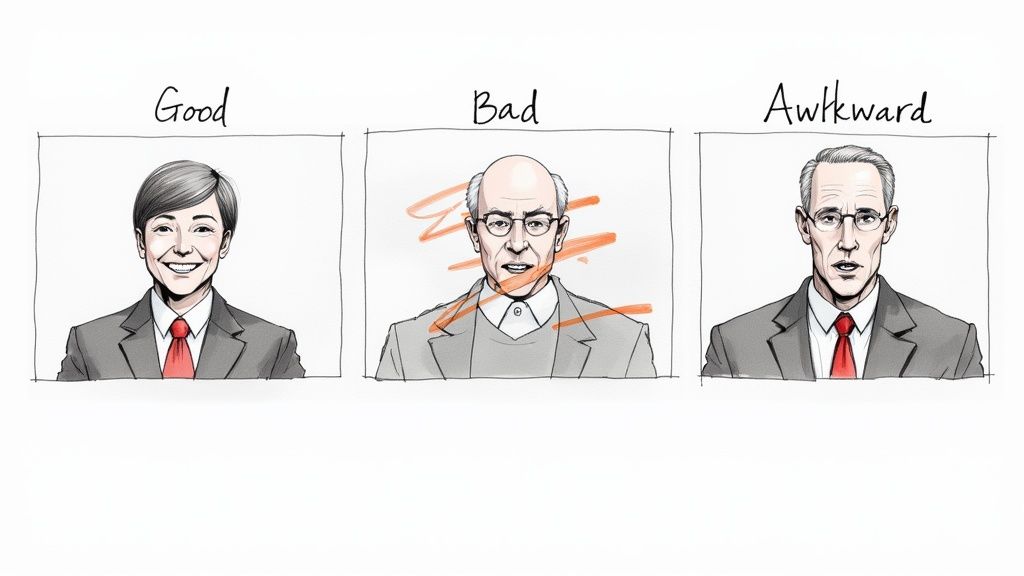
On paper, on-demand video interviewing sounds like a magic bullet. You can save dozens of hours, screen talent from anywhere on the planet, and get way more insight than a flimsy resume could ever provide. It’s the hiring hack we were all promised.
And sometimes, it is. But let's be real—get it wrong, and it can become a candidate-repelling disaster. The line between a slick, modern hiring process and a robotic, impersonal interrogation is thinner than you’d think. Getting this right means seeing the full picture, warts and all.
The Good: Why We Even Bother
The upsides are obvious and incredibly tempting. First and foremost, you get your calendar back. The hours you used to burn on no-shows and painfully awkward 30-minute phone screens can now be spent on, well, anything else.
It’s also a powerful tool for consistency. Every single candidate gets the same questions, asked in the exact same way. This creates a level playing field that’s almost impossible to achieve with a series of live phone screens, helping you make decisions based on substance, not just whether someone had their morning coffee.
But here’s the biggest win: you get to see the person behind the bullet points. You can actually gauge communication skills, confidence, and personality in a way a PDF never could. You’re not just hiring a resume; you’re hiring a future teammate.
The Bad: Where It All Goes Wrong
Now for the flip side. For every candidate who loves the flexibility, there’s another who sees a one-way video interview as a giant red flag. Why? Because it can feel deeply impersonal. Talking to a webcam in an empty room, with zero feedback or human interaction, can be incredibly stressful.
This isn't just a feeling; it has real-world consequences. The data paints a complicated picture. While about half of candidates appreciate the convenience of video interviews, a significant 25% find them more stressful than face-to-face meetings. Even more concerning, a staggering 70% of candidates report having lost out on jobs because of technical glitches they couldn't control. You can dig into more of these candidate experiences and statistics on HireTruffle.
This tells us that while the technology is a game-changer, the execution can easily alienate the very people you’re trying to attract. A poorly designed process doesn’t just screen candidates; it actively pushes good ones away.
Your on-demand video interview isn't just a screening tool. It's a direct reflection of your company culture. If it’s cold, demanding, and robotic, candidates will assume your company is, too.
The Painfully Awkward: Common Mistakes to Avoid
This is where theory crashes into reality, often with cringe-worthy results. We’ve all seen them: the candidate who is clearly reading a script just off-screen, the submission that looks like it was filmed in a closet during an earthquake, or the interview that drags on for ten soul-crushing questions.
These awkward moments aren't really the candidate's fault. They’re a direct result of a poorly designed interview experience. Here are the cardinal sins we see companies commit all the time:
- Asking Too Many Questions: Anything more than five questions is just cruel. You’re not filming a feature-length documentary; you’re getting a first impression. Respect their time.
- Using Generic Prompts: "Tell me about yourself" is just lazy. Ask questions that reveal how they think, solve problems, and approach their work. Make it engaging.
- Providing Zero Context: Don’t just fire off a link. Include a warm welcome video from the hiring manager explaining the process and what you’re looking for. A little human touch goes a long way.
- Ignoring the Tech: Assume nothing. Provide clear instructions, give candidates a chance to test their equipment, and offer a support contact for troubleshooting. Don’t let a bad internet connection cost you a great hire.
Ultimately, the success of your on-demand video interviewing hinges on one thing: empathy. If you design the process from the candidate's perspective—making it clear, respectful, and engaging—you’ll attract top talent. If you treat it like an automated checkbox, you’ll just end up with a folder full of awkward videos and a pipeline of missed opportunities.
How to Design A Video Interview That Doesn’t Suck

Alright, let's be brutally honest for a minute. The vast majority of on-demand video interviews are just plain terrible. They feel like a pop quiz you didn’t study for, run by a robot with no soul. This is your chance to set yourself apart from the lazy competition. A great video interview isn't just a list of questions; it's a thoughtfully crafted experience.
It's your first real opportunity to show a candidate what your company is actually like. Are you organized, respectful, and human? Or are you a bureaucratic mess that sees them as just another number in a spreadsheet? The interview you design sends a loud, clear message.
The goal is simple: make it feel less like an automated test and more like the beginning of a genuine conversation. If you fail at this, you’ll just end up with a folder full of stilted, awkward videos from desperate candidates, while the top talent ghosts you for a better offer.
Start With a Human Welcome
Want to immediately stand out from the pack? Kick things off with a welcome video. I'm not talking about some slick, overproduced marketing reel, but a genuine, 60-second clip from the actual hiring manager.
Just have them introduce themselves, talk briefly about the role, and share what the team is excited about. This one small gesture accomplishes a few powerful things:
- It lowers the stress level: Seeing a real person's face instantly makes the process feel less cold and intimidating.
- It provides much-needed context: Candidates know who they’re "talking" to and why their answers matter.
- It shows you actually care: It signals that you’ve put thought into their experience and value their time.
This isn’t complicated. Just prop up a phone in a spot with decent light and speak from the heart. It's the single easiest way to inject some much-needed personality into the process.
The Magic Number of Questions
This is where most companies completely drop the ball. They treat the video interview like a deposition, firing off ten, twelve, even fifteen questions. That's insane. It's deeply disrespectful of the candidate's time and all but guarantees you'll get rushed, low-quality answers.
So, what's the sweet spot? Three to five questions. Maximum.
Anything more than five questions is a sign that you don't really know what you're looking for. You're just throwing spaghetti at the wall and hoping something sticks. It’s lazy hiring, plain and simple.
Remember, you aren’t trying to learn everything about them in this single step. Your only job here is to figure out if they’re worth a 30-minute live conversation. Keep it focused, keep it brief, and you’ll get far more thoughtful responses.
Ask Questions That Actually Reveal Something
Stop asking candidates to just regurgitate their resume. It’s a complete waste of a question. You already have their resume—you're supposed to have read it. The whole point of an on demand video interviewing platform is to go deeper and see how a person thinks.
Instead of tired, generic prompts, ask questions that reveal personality, creativity, and problem-solving skills. A great question is an invitation for them to tell a story or demonstrate their craft.
Here are a few examples of questions that don’t suck:
- For a Developer: "Pick a piece of code from a personal project you're proud of. Share your screen and walk us through your thought process in one or two key sections."
- For a Marketer: "Imagine we just gave you a $10,000 budget for a wild, creative campaign for our product. No bad ideas. Pitch us your concept."
- For a Sales Rep: "Tell us about a time a deal went completely sideways. What happened, and what did you learn from the experience?"
- For a Customer Support Specialist: "Describe a time you had to deliver bad news to a frustrated customer. How did you handle that conversation?"
See the pattern? These questions can't be answered by a quick Google search. They require candidates to think on their feet and show you a glimpse of who they really are—something far more telling than asking them to "describe their greatest weakness."
Perfecting the art of capturing these authentic moments is crucial. You can learn more about refining your technique by exploring the best practices for video interview recording. It’s all about creating an environment where authenticity can shine through, even through a screen.
Is On Demand Video Interviewing Right For You
So, here’s the million-dollar question: should you mortgage the office ping-pong table for an on demand video interviewing platform? Let's get one thing straight—this isn't some magic elixir that cures all your hiring woes. It's a powerful tool, but like any tool, it’s only as good as the person using it.
Frankly, for some companies, it can be total overkill. If you’re a tiny startup hiring two people a year, just stick to conversations. You don't need this. But if you're drowning in applications, scaling quickly, or building a remote-first team, ignoring this tech is just leaving efficiency on the table.
It shines brightest in specific scenarios: high-volume roles, the initial screening stages, and for companies that have outgrown the "let's just hop on a quick call" phase of their existence.
A Pragmatic Checklist
Before you jump in, grab a coffee and ask yourself a few blunt questions. No corporate fluff, just the real talk. Your answers will tell you everything you need to know.
- Is scheduling your full-time job? If your calendar looks like a game of Tetris gone wrong and you spend more time coordinating schedules than actually talking to candidates, it’s time for a change.
- Are you hiring for remote roles? Trying to manage time zones for phone screens is a nightmare. Asynchronous interviews let you screen talent from anywhere on the planet without losing sleep.
- Do you get a flood of applicants? When you have 200+ applicants for one role, you physically cannot speak to everyone. This lets you give more people a fair shot without burning out your team.
- Is your team struggling to collaborate? If hiring decisions are stuck in a bottleneck because one key person is always in meetings, shared video reviews can break that logjam.
If you answered "yes" to most of these, then you’re in the right territory. This isn't just a "nice-to-have"; it’s a strategic lever you can pull to get ahead. When considering if on-demand video interviewing is right for your organization, it's essential to understand the broader strategies for how to hire remote employees effectively.
The Final Word
Ultimately, this is about reclaiming your time and making smarter decisions. The popularity of this approach isn't just hype; candidates and companies are both seeing the benefits. In 2025, 49% of job candidates reported that video interviews help them stand out, and 61% of companies now prefer them for attracting top talent. You can check out more insights about candidate preferences on iMocha.io.
Implemented thoughtfully, on demand video interviewing is one of the most powerful tools for scaling your hiring. Done poorly, it's just an expensive way to make a terrible first impression.
The choice is yours. You can keep doing things the old, painful way, or you can build a modern process that respects everyone's time—yours and the candidates'. Just don't blame me when your competitor beats you to the best hires because their screening process is twice as fast.
Frequently Asked Questions
Alright, let's tackle the big questions. You've heard the spiel, but you're still on the fence. Good. Healthy skepticism is what separates smart decisions from costly mistakes. Here are the straight-up answers to the questions we hear most often from founders and hiring managers in the trenches.
Will This Make Us Look Like Robots?
This is the big one, isn't it? The fear that on-demand video interviewing will create a cold, impersonal candidate experience. And honestly? It absolutely can—but only if you’re lazy about it. A bad experience comes from a thoughtless process: too many questions, soulless text prompts, or a clunky platform that looks like it was designed in 1998.
But it doesn't have to be that way. Imagine a process that starts with a warm, personal welcome video from the hiring manager. Follow that with a few sharp, relevant questions and crystal-clear instructions. Suddenly, it feels modern and respectful. It shows you value a candidate's time far more than making them jump through scheduling hoops for a quick 15-minute phone screen.
How Do We Reduce Hiring Bias?
This is where structure becomes your secret weapon. Unconscious bias thrives in the chaos of unstructured, "gut feeling" conversations. An on-demand video interview forces you to standardize your initial screening in a way that’s nearly impossible with a round of live phone calls.
The key is consistency. When every single candidate for a role answers the exact same questions, in the exact same format, you’re no longer comparing personalities on a random Tuesday morning. You’re comparing substance. It's apples to apples.
To really nail this, you need two things: a standardized set of questions and a consistent scoring rubric for your team to follow. This simple framework ensures your evaluations are based on the quality of the answers, not on hidden biases. It’s a more equitable process by design.
Is This Only for Big Companies?
Not a chance. While this approach is a lifesaver for high-volume roles, the logic is just as powerful for startups and small businesses. If you're running a lean team, your time is your most precious asset. Wasting it on endless scheduling emails and repetitive screening calls is death by a thousand cuts.
Think of it this way: automating the top of your hiring funnel saves you and your team countless hours. Those are hours you can now reinvest in what truly matters—building your company and having deep, meaningful conversations with your top candidates in the final rounds. This isn't about company size; it's about being ruthlessly efficient.
Ready to stop wasting time and start hiring smarter? Async Interview gives you the tools to build a human-centric, highly efficient on-demand video interviewing process. Start your free trial today and see just how much time you can get back.
